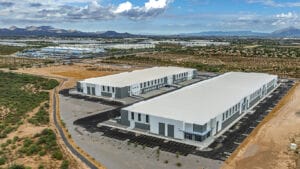In Arizona, the evolution of commercial real estate development isn’t found in brand new residential towers in Central Phoenix or 1 million-square-feet warehouses in the West Valley. The future of commercial development is going on in well-known locations that are just getting a fresh set of eyes on them.
At the 15th annual ULI Arizona Trends Day on February 26 at the J.W. Marriott Phoenix Desert Ridge Resort, one of the marquee discussions of the day was the panel titled, “The Future of Commercial Development.” The panel, moderated by Betts Real Estate Advisors Founder Steve Betts, included some well-known faces in the world of commercial real estate in Arizona. Developers like David Krumwiede, executive vice president at Lincoln Property Company; and Sharon Harper, president and CEO at Plaza Companies have brought to market high-profile, high-value developments like The Grand and SkySong. Also on the panel were David Scholl, partner at Vintage Partners, and Keri Silvyn, partner and owner at Lazarus & Silvyn, P.C.
The future of commercial development is in places like Park Central, where Harper and Plaza Companies have converted an old retail center, once the heart of Central Phoenix, and turned it into a true mixed-use destination.
“For the first time in my career, a mixed-use development is finally being reflective of good placemaking and good lifestyle decisions,” said Scholl when discussing developments like Park Central and Block 23. “I think this cycle, we’re actually seeing mixed use in Phoenix come into its own where it’s really a response to the lifestyles people want to live and the destinations they want to frequent, which is really a first for Phoenix.”
Scholl said he feels that the disruption in retail is far from over. He said he expects that retail developments will continue to morph in the future to reflect a better balance between brick and mortar locations and internet shopping.
Scholl shared a little information about one project he is consulting on in Florida. The site is a mall location with ample parking fields that developers what to fill with towers that will bring office, retail and multifamily elements to the area. He said this is the kind of mixed-use concept that could revitalize the outdated suburban malls that are floundering in todays marketplace.
“I think that those mall owners that recognize that their mall is not a survivor, they will immediately look and ask if they are in a location or a demographic that might support a complete overhaul and turn more suburban malls into more urbanized areas,” Scholl said. “A lot of apartment developers have responded to that and I think some of these shopping destinations that have been that way for 30 or 40 years could be converted into live-work-play destinations.”
Silvyn, whose law office is in Tucson, is seeing some of that mall conversion in her own city. At Tucson Mall, the empty Sears anchor site was converted into a Round 1 entertainment, arcade and bowling location. Round 1 is a Japan-based chain of family entertainment centers that include bowling, arcade and billiards, along with a restaurant and bar.
“That’s the tie-in that they are looking to create,” Silvyn said. “You can still walk around and interact with the retailers and there are a lot more restaurants on the exterior and a lot more retail places turning into restaurants and entertainment places. We’re starting to see the larger malls reposition that way and really mixing uses.”
Silvyn also brought up the One South Church building in Tucson. This 23-story tower in downtown Tucson is the tallest building in the city and was supposed to include another tower, which has yet to be developed.
Scottsdale-based Opwest Partners is planning to convert the first eight floors of One South Church into a hotel, with 150 guest rooms, meeting space and restaurant and outdoor space. Opwest is making a $38 million investment to convert the building into a true, mixed-use site.
“Now we have a block in downtown Tucson that still has 15 floors of office space, and then we’ve got living and hospitality, all within a city block,” Silvyn said. “The modern streetcar stop is right there, so transit is there, and it’s right in the heart of our revitalized downtown where we still have bars and restaurants and some retailers.”
Both Scholl and Silvyn think that converting single-use buildings into mixed-use will continue as the commercial real estate development community tries to meet the wants and needs of the younger generation.
Krumwiede’s Lincoln Property Company is coming off some very large industrial and office projects, like the 1 million square foot Lincoln Logistics 40 building that his company sold to Nike. Krumwiede sees the evolution of the industrial building happening at a rapid rate and mirrors, in large part, how office projects will look and function moving forward.
“I’ve said before that these are not your traditional dusty old warehouses with a few forklifts rolling around,” Krumwiede said. “They are true employment centers that we’re building with a ton of amenities, including 40 foot clear height to support high e-commerce-level throughout. We’re replacing skylights with clerestory windows that bring more natural light into the work environment and outdoor amenity spaces with shaded seating, built-in barbeques and game areas.
“The office inventory has evolved in a similar fashion. All of our projects from The Grand to Union have collaborative indoor/outdoor lobbies, rooftop decks and open office floorplates with 12-foot glass. In general they are exponentially more sophisticated and more in tune with global trends as it relates to employee attraction, retention and efficiency.”




